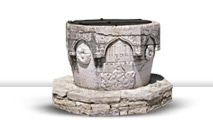
- Sečovlje Salt Pans - Dragonja River Valley
- Sv. Peter - Nova vas - Padna
- Pomjan - Nature Park: Karst Edge - Socerb
- Črni Kal - Osp - Kubed
- Momjan - Grožnjan - Pietrapelosa - Mirna
- Baštija - Kostanjica - Parenzana
- Oprtalj - Završje - Livade - Zrenj
- Istarske toplice - Motovun Forest - Višnjan
- Cave Mramornica - Feštini Kingdom - Cave Baredine
- Lim Bay - Kloštar - Kontija - Dvigrad
- Kanfanar - Bale - Palud - Vodnjan - Brijuni - Fažana
- Svetvinčenat - Tinjan - Pićan - Gračišće
- Belaj - Šumber - Kožljak - Paz
- Čepićko Field - Kršan - Boljun Castle - Lupoglav
- Plomin - Kvarner Gulf - Brseč
- Nature park Učka - Mošćenice
Svetvinčenat - Tinjan - Pićan - Gračišće
Tinjan
The local history dates from about 1500 BC, which is testified by the grave on Sv. Špete hill. In the Roman times the road connecting Poreč and Pazin passed here. Most probably the area of Tinjan was given as a reward to a Roman soldier, whereas its present-day name is of Slavic origin.
In the Middle Ages its destiny was defined by - marriage, which, together with the Castle of Pazin, brought it into the hands of the Counts of Gorizia. It served its purpose well: Tinjan's fort guarded the frequently attacked western border towards the properties of the Patriarchs of Aquileia, just as it did for the royal Habsburg family in the 14th c. until the arrival of Napoleon, the unstable border of the County of Pazin towards properties of Venice. Although it was situated on the very border, Tinjan was not an ordinary fortress, but instead was referred to as a town in the 16th c.
It was surrounded by a moat, while just one gate, a drawbridge led to the town. Tinjan also had a loggia with a pillar of shame in front of it. The main street was mostly inhabited by craftsmen, guards and tradesmen. Not many people know that in the 15th c. an underground part of Tinjan was built, which connected all major parts of the town by corridors.
The Prefect's table in Tinjan bears testimony to the medieval local government. Seated at the table, in the deep shade of hackberry trees, the district prefect and local government decided on all important issues. During the Middle Ages, Tinjan, together with Gračišće, was one of the wealthiest towns in Istria.
The town nurtures the old craft of blacksmiths, so a festival of billhooks and other blacksmith products from all parts of Istria is held each year. It is also famous for a large number of dry stone field huts kažuni, and their peculiar square shape as well. An Istrian specialty that is being promoted lately and has become a trademark of Tinjan is Istrian prosciutto.
Some of the attractions from its rich history are the Prefect's table under the hackberry tree (ladonja), Parish Church of SS. Simon and Jude the Apostle from the 18th c. and detached 28-meter belfry which differs from most Istrian belfries by its crenellation adding a unique touch to the panorama of Tinjan. The Church of the Holy Cross, situated outside the town, by the road, was erected at the end of the 13th c.
An interesting fact is that Tinjan is the native town of the famous linguist and lexicographer Josip Voltić, author of the three-lingual dictionary (Ričoslovnik) published in Vienna in 1803; also the town where the Istrian and Trieste Bishop Juraj Dobrila, a native of nearby Ježenje, was educated.
Напечатай страницу Отправь другу
















